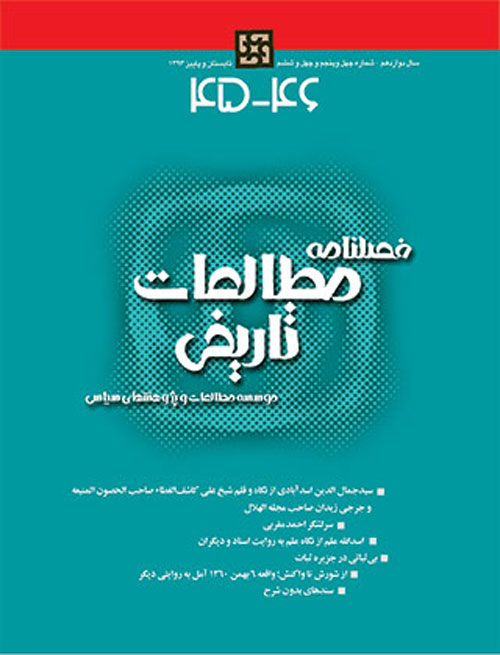فهرست مطالب

نشریه مطالعات تاریخی
پیاپی 45-46 (تابستان و پاییز 1393)
- تاریخ انتشار: 1393/08/20
- تعداد عناوین: 7
-
صفحه 8
-
صفحه 51
-
صفحه 193
-
صفحه 255
-
Page 11The late Sheikh Ali Kashef Alghetaa Najafi is an Iraqi clergy who has written some pages about Seyyed Jamaleddin Assadabadi in book titled: Al-hasoon Al-mani’ah Fi Tabaqat Al-Shia. This 10-volume-book has not been published yet and its manuscript is kept in Kashef Alghetaa Library in Najaf. However, the Bi-Quarterly of Ketab-e Shia, published in Qum, in its first issue in 2010 published these pages of this great book about Seyyed Jamaleddin Assad Abadi edited by respected and knowledgeable Reza Mokhtari and has some Arabic notes. Parts of this text are the findings and viewpoints of the late Sheikh Ali the writer of Al-hasoon Al-mani’ah and another part is quoted from Mashahir Al-mashreq by Jurji Zaydan. Sheikh at the end of his text and also in the end of Jurji Zaydan’s (which you will read both) has shown a clever lack of interest in biography-writing made by Jurji Zaydan. Since the text by one of prominent Imami Shia clergy about Seyyed Jamaleddin Assad Abadi is published for the first time and its Persian translation was a must-read text for Persian readers, the writer has tried to translate this text and also add some notes to introduce and document some names and points in footnotes.
-
Page 51Few months after the victory of Islamic revolution, this newly stablished government was involved in an obstreperous spy file. On April 26, 1979 a high-ranking member of MKO (Mujahedin Khalq Organization), Mohammad Reza Saadati at the time of meeting with Vladimir Fensenco, first secretary of Soviet Embassy in Tehran and a member of KGB was arrested. In this meeting Saadati was planned to give a copy of General Ahmad Moqarrabi file to Fensenco. In 1978, a year before Revolution he was arrested and executed because of spying for USSR. The Russians were persistence to know how this give-and–take was revealed, so they tried to solve this puzzle as soon as possible, however, Saadati’s arrest did not let the Soviet puzzle being solved.
-
Page 133Something which is absorbed from analyzing SAVAK documents about Alam political life is his relation with UK-in a particular wayand USA via their officials inside Iran. This relation is reinforced and fins more importance when he becomes court minister. His political character was trying to achieve his goals –whether being legitimate or illegitimate- through the “door” not jumping over the “wall”. He was more experienced than making mistakes in achieving something; in a way that he advised Mohammad Reza Shah with such advices several times.
-
Page 193On December 21, 1977 when President Carter called Iran the “Stability Island” in presence of the Shah in Tehran, he would never thought that in few days this Stability Island would be entrapped in a crisis and instability that would end the regime fall with all its military might and power and support from the foreign powers. On that night, Shah, Rosaline, Carter and Farah drank the wine classes on the Christmas Eve in a way that Iran was the paradise and would be calm forever. However, few days after the Carter’s optimistic lecture the flames of Revolution lighted on December 30 and by subsequent developments in other cities a storm was shaped that smashed the Imperial Stability Island. The years of 1978-1979 were expecting some political developments against the Pahlavi Reign the showed themselves from the early days. The years observed subsequent increasing struggles of people.
-
Page 235The event of January 26, 1982 in Amol is one of the greatest politicalsecurity events after the victory of Islamic Revolution that was concurrent with the Imposed War. At the time that the military forces of Baseej (volunteer soldiers) and Sepah (Islamic Revolution Guards Corps) were fighting in the western and southern fronts with Iraqis and Kurdish antirevolutionary forces, a group of Ettehadiyyeh Komonist-haaye Iran (Iranian Communist Union) or Sarbedaran who were China’s Mao followers, after the events of June 19, 1981, and abdication of Bani Sadr from presidency, changed their approach from political phase to the military and took arms. This group chose the strategic town of Amol for its urgent rise, because of the deep forests and rural context and closeness to Tehran. Iranian Communist Union had plans to occupy Amol and other cities of Mazandaran and then go to Tehran and demolish The Islamic Republic System; however they faced with urgent reaction of Amol people on January 26, 1982 and could not achieve their goals.
-
Page 255On May 13, 1948 in a session where Zionists gathered around in Tel Aviv, the announcement of Israel founding presented. Very soon the Jews around the world hurried to live in the promised land of Palestine. Iranian Jews were not an exception as well and some groups of them emigrated to Palestine. Sometime after traveling to Israel Iranian emigrant Jews became tired of being there, however, there were no way back; since the Zionists had confiscated their passports and ID documents. Sending all the girls and boys to compulsory military service had increased dissatisfaction wave. The “No Comment Documents” section in this issue shows such affairs reflected in Iranian Foreign Ministry correspondence during the Pahlavi regime.

